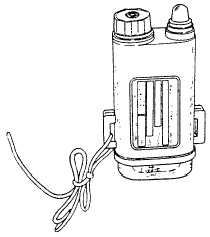end is for day use. The night end produces a red flame;
the day end produces orange smoke. Each end burns for
about 20 seconds. The night end has bumps around its
outer edge, approximately one-quarter inch from the
end. This identifies it as the night use end. Follow the
instructions printed on the signal.
Mk 124 Mod 0 Marine Smoke and
Illumination Signal
The Mk 124 Mod 0 marine smoke and illumination
signal (fig. 11-28) is also used for either day or night
signaling by personnel on land or sea. It is a ONE hand
operable device that emits orange smoke for daytime
use and red flare for nighttime use. Burning time for
each end is about 20 seconds. Each end has protective
plastic caps. The night end has two prominent raised
bead circles on the casing to positively identify this end,
by the sense of touch, for nighttime use. A label on the
outer surface around the whole body of the signal
further identifies the smoke (day) and flare (night) ends.
The label also gives detailed instructions on how to use
the signal.
Distress Marker Light (Strobe)
The battery-operated strobe light (fig. 11-29) emits
a high-intensity white flashing light 40 to 60 times per
minute. The light is visible at great distances and is
used to attract the attention of SAR aircraft, ships, or
ground rescue parties. It is located in a pouch attached
to the personal flight deck inflatable life preserver and
other rescue kits. An infrared filter lens and a blue flash
guard lens are provided in the individual survival kit for
signaling in combat areas.
SURVIVAL RADIOS AND BEACONS
There are several types and models of survival
radios and beacons that are carried on personnel, in
aircraft, or stowed inside life rafts. Radios and beacons
are used for different purposes. Radios are used to
establish two-way communication, on one or more
channels, between aircrew and rescue personnel.
Beacons transmit only a swept tone signal for search
and rescue (SAR) parties to home in on. Radios and
beacons are sometimes combined into one system.
Instructions for use of survival radios and beacons
are on instruction plates as part of the equipment.
Q11-14. How many parts are there to the individual
survival kit?
Q11-15. How many flares are contained in the Mk 79
Mod 0 Illumination kit?
Q11-16. What hand-held signaling device produces an
orange smoke?
RESCUE
LEARNING
OBJECTIVE:
Identify
items of land and sea rescue equipment
and their uses.
Land and sea rescue starts when a distress is
reported or when a reporting point or arrival time is
exceeded. Both military and civilian authorities may
react to an emergency. This is called search and rescue
(SAR).
Search and rescue craft could be anything from a
ship, boat, or fixed-wing aircraft to a fully equipped
rescue helicopter with rescue swimmer. The method of
searching and rescuing personnel depends on a great
many factors, such as location, time, environment,
equipment, and personnel. Ditching or bailout often
occurs a great distance from a rescue craft. When this
happens, military aircraft are diverted or launched to
the SAR area.
At
sea,
fixed-wing
aircraft
equipped
with
droppable life raft kits may arrive at the scene and drop
a raft to the survivors until the rescue helicopter or
surface vessel arrives. The SAR life raft provides
communications, medical, and survival items.
RESCUE EQUIPMENT
All naval personnel should be familiar with the
equipment used in rescue. The following text discusses
rescue equipment and lifting devices that may be used.
Hoisting Cable and Rescue Hook
Assembly
The primary rescue device used in helicopter
rescue is the hoisting cable and double rescue hook
11-21
ANf1129
Figure 11-29.—Distress marker light (strobe).

